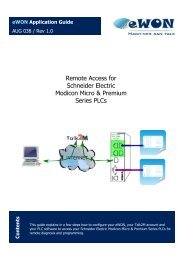eWON General Reference Guide - eWON wiki
eWON General Reference Guide - eWON wiki
eWON General Reference Guide - eWON wiki
You also want an ePaper? Increase the reach of your titles
YUMPU automatically turns print PDFs into web optimized ePapers that Google loves.
3.3.4.3.6 Proxy<br />
3.3.4.3.6.1 Why a proxy feature?<br />
<strong>General</strong> <strong>Reference</strong> <strong>Guide</strong> <strong>eWON</strong> Configuration<br />
Since firmware 5.2, the <strong>eWON</strong> has a built-in ProxyServer.<br />
The Proxy feature is similar to the transparent forwarding, with some advantages and some drawbacks.<br />
To be precise, it is not exactly equivalent to the transparent forwarding that forwards all the ports (except the 81), but more like a "port forwarding"<br />
feature that would forward some ports.<br />
The main advantage of the proxy implementation is that the "proxy's destination device" must NOT define the <strong>eWON</strong> as its gateway.<br />
3.3.4.3.6.2 Comments on the proxy feature<br />
• Overhead<br />
There is an important difference between a forwarded packet and a proxied packet . When the packet is forwarded, it is modified at a very low<br />
level of the stack, then it is immediately resent without any further interpretation, manipulation or storage.<br />
When the packet is proxied, the stack must first maintain storage for the proxied sockets, then every packet must walk the stack all way up to<br />
the proxy application, then all the way down to be resent.<br />
This means an additional load for the system.<br />
• Proxied ports must be known and configured<br />
In "Forwarding" mode all ports are forwarded, there is no need to configure anything.<br />
In Proxied mode, the user must know what port(s) he wants to forward and what protocol (UDP,TCP, FTP) will flow on the port.<br />
• More intrusive content<br />
As said before in "Forwarding" mode, the packet is resent "as received". If it contains 4 bytes, 4 bytes are resent. This is not true in the proxy<br />
mode as the received data are (at least may be) re-aggregated at the proxy level.<br />
Example: if the client sends a 4 bytes packet followed by a 2 bytes packet, then the proxy can resend a 6 bytes packet to the "proxy's<br />
destination device". From a TCP point of view, there is no difference, but from a behavior point of view, there is a slight difference.<br />
One must check what protocol are considered here with the "proxy's destination device" and check if there is a chance that the proxy may<br />
disturb the client-"proxy's destination device" discussion.<br />
3.3.4.3.6.3 Configuration.<br />
Figure 52: Proxy configuration page<br />
RG-001-0-EN ver 1.14 <strong>eWON</strong>® - 02/05/2012 - ©<strong>eWON</strong> sa Page 62



